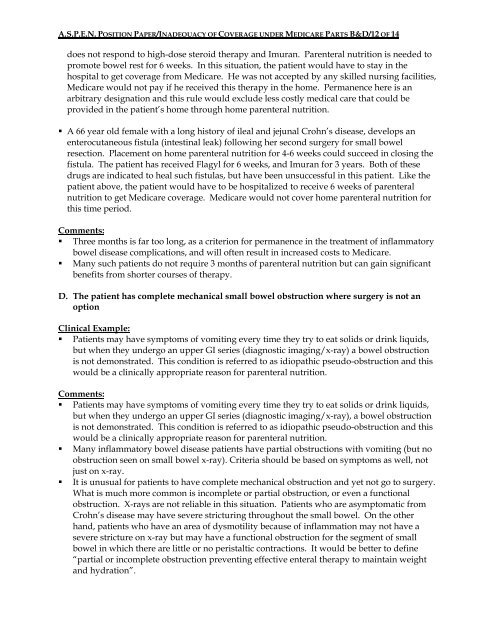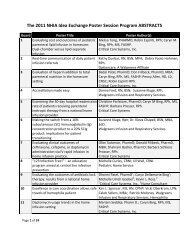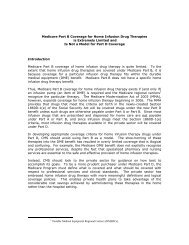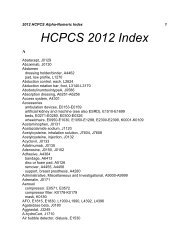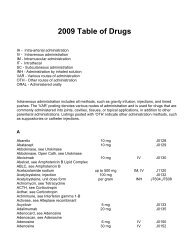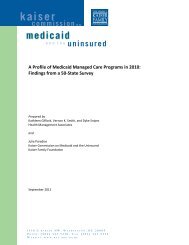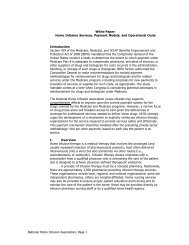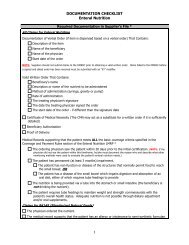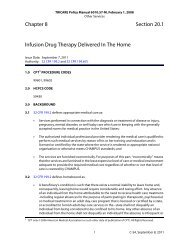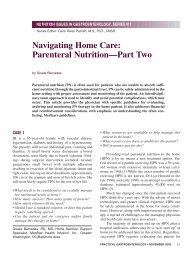Inadequacy of Coverage Under Medicare Part B and - NHIA
Inadequacy of Coverage Under Medicare Part B and - NHIA
Inadequacy of Coverage Under Medicare Part B and - NHIA
You also want an ePaper? Increase the reach of your titles
YUMPU automatically turns print PDFs into web optimized ePapers that Google loves.
A.S.P.E.N. POSITION PAPER/INADEQUACY OF COVERAGE UNDER MEDICARE PARTS B&D/12 OF 14<br />
does not respond to high-dose steroid therapy <strong>and</strong> Imuran. Parenteral nutrition is needed to<br />
promote bowel rest for 6 weeks. In this situation, the patient would have to stay in the<br />
hospital to get coverage from <strong>Medicare</strong>. He was not accepted by any skilled nursing facilities,<br />
<strong>Medicare</strong> would not pay if he received this therapy in the home. Permanence here is an<br />
arbitrary designation <strong>and</strong> this rule would exclude less costly medical care that could be<br />
provided in the patient’s home through home parenteral nutrition.<br />
• A 66 year old female with a long history <strong>of</strong> ileal <strong>and</strong> jejunal Crohn’s disease, develops an<br />
enterocutaneous fistula (intestinal leak) following her second surgery for small bowel<br />
resection. Placement on home parenteral nutrition for 4-6 weeks could succeed in closing the<br />
fistula. The patient has received Flagyl for 6 weeks, <strong>and</strong> Imuran for 3 years. Both <strong>of</strong> these<br />
drugs are indicated to heal such fistulas, but have been unsuccessful in this patient. Like the<br />
patient above, the patient would have to be hospitalized to receive 6 weeks <strong>of</strong> parenteral<br />
nutrition to get <strong>Medicare</strong> coverage. <strong>Medicare</strong> would not cover home parenteral nutrition for<br />
this time period.<br />
Comments:<br />
• Three months is far too long, as a criterion for permanence in the treatment <strong>of</strong> inflammatory<br />
bowel disease complications, <strong>and</strong> will <strong>of</strong>ten result in increased costs to <strong>Medicare</strong>.<br />
• Many such patients do not require 3 months <strong>of</strong> parenteral nutrition but can gain significant<br />
benefits from shorter courses <strong>of</strong> therapy.<br />
D. The patient has complete mechanical small bowel obstruction where surgery is not an<br />
option<br />
Clinical Example:<br />
• Patients may have symptoms <strong>of</strong> vomiting every time they try to eat solids or drink liquids,<br />
but when they undergo an upper GI series (diagnostic imaging/x-ray) a bowel obstruction<br />
is not demonstrated. This condition is referred to as idiopathic pseudo-obstruction <strong>and</strong> this<br />
would be a clinically appropriate reason for parenteral nutrition.<br />
Comments:<br />
• Patients may have symptoms <strong>of</strong> vomiting every time they try to eat solids or drink liquids,<br />
but when they undergo an upper GI series (diagnostic imaging/x-ray), a bowel obstruction<br />
is not demonstrated. This condition is referred to as idiopathic pseudo-obstruction <strong>and</strong> this<br />
would be a clinically appropriate reason for parenteral nutrition.<br />
• Many inflammatory bowel disease patients have partial obstructions with vomiting (but no<br />
obstruction seen on small bowel x-ray). Criteria should be based on symptoms as well, not<br />
just on x-ray.<br />
• It is unusual for patients to have complete mechanical obstruction <strong>and</strong> yet not go to surgery.<br />
What is much more common is incomplete or partial obstruction, or even a functional<br />
obstruction. X-rays are not reliable in this situation. Patients who are asymptomatic from<br />
Crohn’s disease may have severe stricturing throughout the small bowel. On the other<br />
h<strong>and</strong>, patients who have an area <strong>of</strong> dysmotility because <strong>of</strong> inflammation may not have a<br />
severe stricture on x-ray but may have a functional obstruction for the segment <strong>of</strong> small<br />
bowel in which there are little or no peristaltic contractions. It would be better to define<br />
“partial or incomplete obstruction preventing effective enteral therapy to maintain weight<br />
<strong>and</strong> hydration”.


